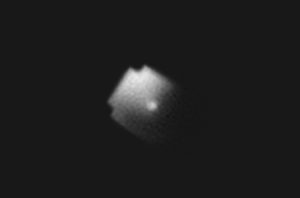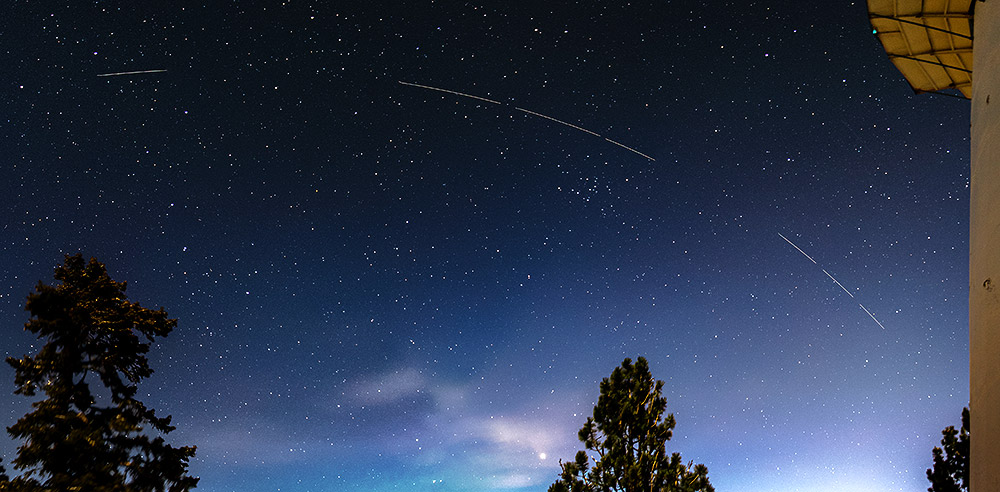October 6, 2023 Reading time: 4 minutes.
Orbital interference effects: A satellite launched a year ago outshines even the brightest stars in the night sky — much to the chagrin of astronomers. According to their observations, the BlueWalker 3 satellite’s 64-square-meter antenna reflects so much sunlight that it temporarily reaches +0.4. It is therefore much brighter than the North Star. Their transmissions also interfere with radio telescopes, the team reports in the journal Nature Astronomy. But this satellite is just one of more than 100 still planned.
Light pollution in the night sky is increasing rapidly. Three-quarters of the world’s major astronomical observatories no longer see completely dark skies, and intermittent light reflections frequently disrupt telescope images. Satellites and groups of satellites in Earth’s orbit are primarily responsible for this. Their solar sails and antennae reflect sunlight, creating overlapping lines and scattering scattered light.

Flashes once started
A particularly striking example of this orbital turbulence effect is the BlueWalker 3 satellite, which was launched into orbit in September 2022. The communications satellite operated by AST SpaceMobile serves as a prototype for an entire network of more than a hundred such satellites. In the future, they will enable mobile communications via satellite by establishing direct connections to mobile phones on the ground.
But just after BlueWalker3 launched, the first astronomers sounded the alarm: The satellite had reflected so much sunlight that it shone brightly in the evening sky. In order to investigate the problem in more detail, the International Astronomical Association (IAU) then launched an international observing campaign, in which several large telescopes as well as amateur astronomers around the world directed the satellite at different times for more than 130 days.
Brighter than the North Star and almost all other stars
Now the result is available. Observations revealed that the bright glow of the satellite shortly after its launch was not a temporary phenomenon. Instead, BlueWalker 3 constantly shines brightly as it orbits Earth because its 64-square-meter antennae reflect sunlight. According to measurements, its magnitude reaches +0.4. It shines brighter than the North Star and is one of the ten brightest star-like objects in the night sky.
“As is the case with all satellites, the apparent brightness of BlueWalker 3 is not constant and varies with the angle of the sun and its position in the sky,” explain Sangeetha Nandakumar of the University of Atacama in Chile and colleagues. A satellite always appears particularly bright when it is relatively high above the horizon. “This is a global problem because satellites are visible in the sky all over the world, regardless of their country of origin,” says Jeremy Tregloan-Reid, Nandakumar’s colleague.
Also disturbed by radio telescopes
But these and other satellites don’t just pose a problem for optical telescopes: Current observations have also revealed that satellite constellations designed for portable satellite communications could also significantly disrupt radio astronomy: “The new thing about BlueWalker 3 is that it uses frequencies,” which “It is usually only used by ground-based broadcasters,” explains Federico Di Frono of the International Astronomical Union. “It transmits data at radio frequencies close to the observation frequencies of radio telescopes.”
Normally, several communication and radio frequency bands are reserved for radio astronomy – thus transmitters are not allowed to use this wavelength for transmission. “However, the downlink frequencies of the BlueWalker 3 gateway are 37.5 to 42 and 42 to 42.5 GHz,” the astronomers reported. “This puts them in the protected range of 42.5 to 43.5 GHz.”
In addition, the satellite transmits via mobile phone at frequencies ranging from 750 to 900 MHz. “This may be particularly problematic for radio telescopes such as the Green Bank Telescope and the Square Kilometer Array (SKA) because they monitor mobile phone frequencies within or near them,” Nandakumar and colleagues said. These telescopes are usually well protected against cell phone radiation from ground-based antennas, but not when that radiation comes from the sky.
More and more orbital interference effects
According to the team of astronomers, the BlueWalker 3 satellites exacerbate the problem of orbital light and radiation pollution even more than the smaller satellites already in the massive constellations like Starlink and Co. “Satellites are satellites,” says co-author Siegfried Eagle of the University of Illinois at Urbana-Champaign. “This is concerning given the numerous launches still planned.”
Such satellites can improve communications, especially in sparsely populated areas. “But it is urgent to minimize imbalances in scientific observations,” Eagle says. For example, it might be conceivable to implement measures to protect against reflections, such as those SpaceX has already partially implemented for its Starlink satellites. AST SpaceMobile also stated that it wants to use such anti-reflective coatings for future generations of satellites. In addition, some flight maneuvers are intended to reduce light reflections. (Natural Astronomy, 2023; doi: 10.1038/s41586-023-06672-7)
Source: International Astronomical Union, NOIRLab
October 6, 2023 – Nadia Podbrigar

“Social media evangelist. Baconaholic. Devoted reader. Twitter scholar. Avid coffee trailblazer.”








More Stories
Longest jets in the universe discovered – giant particle streams as long as 140 Milky Way galaxies in a row
New method reveals 307 supernova remnants
Snapchat is upping the ante on augmented reality glasses